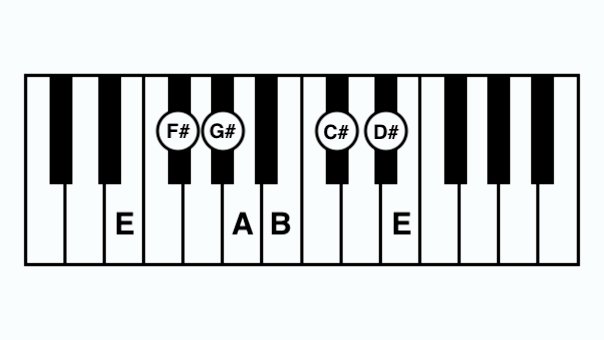The E major scale has a rich, resonant sound that shows up in everything from classical compositions to rock, pop, and jazz. If you’ve already learned simpler scales like C, G, or D major, E major is a great next step that introduces a few more sharps and helps build finger coordination. In this lesson, you’ll learn the notes of the E major scale, the correct fingerings for each hand, and some helpful tips for practicing it effectively.
E Major Scale Notes
The E major scale follows the same formula used for all major scales:
Whole, Whole, Half, Whole, Whole, Whole, Half
Starting on E, this gives us the following notes:
E – F♯ – G♯ – A – B – C♯ – D♯ – E
The E major scale has four sharps in its key signature: F♯, G♯, C♯, and D♯
E Major Scale on the Keyboard
Here’s what the E major scale looks like visually on the piano:

- E (white key)
- F♯ (black key)
- G♯ (black key)
- A (white key)
- B (white key)
- C♯ (black key)
- D♯ (black key)
- E (white key, one octave higher)
Take a moment to locate these notes on your keyboard before moving on to fingering.
Right-Hand Fingering
For the right hand, use this finger pattern when ascending:
1 – 2 – 3 – 1 – 2 – 3 – 4 – 5
Here’s how it aligns with the scale:
- E – 1 (thumb)
- F♯ – 2
- G♯ – 3
- A – 1 (thumb crosses under)
- B – 2
- C♯ – 3
- D♯ – 4
- E – 5
To descend, reverse the pattern:
5 – 4 – 3 – 2 – 1 – 3 – 2 – 1
As you ascend, tuck your thumb under your third finger after G♯. When descending, cross your third finger over your thumb after B.
Left-Hand Fingering
For the left hand, the ascending pattern is:
5 – 4 – 3 – 2 – 1 – 3 – 2 – 1
And descending:
1 – 2 – 3 – 1 – 2 – 3 – 4 – 5
Here’s how it matches with the notes:
- E – 5 (pinky)
- F♯ – 4
- G♯ – 3
- A – 2
- B – 1 (thumb)
- C♯ – 3 (cross over)
- D♯ – 2
- E – 1
Just like the right hand, smooth finger crossing is key for fluid playing.
Practice Tips
- Start slowly and focus on accuracy and correct finger placement.
- Use a metronome to develop consistent rhythm.
- Say the note names aloud to build familiarity.
- Practice each hand separately before combining them.
- Once you’re comfortable, try playing two or more octaves.
- Practice both ascending and descending the scale.
Why Learn the E Major Scale?
Learning the E major scale helps you:
- Strengthen finger independence and technique
- Understand the key signature of E major (and its relative minor, C♯ minor)
- Prepare for pieces written in E major, commonly found in genres like rock, gospel, and pop
This scale appears in songs by artists like Coldplay, The Beatles, Adele, and many more. It’s also a foundational scale for guitar-based music, making it especially useful if you collaborate with other musicians.




